Andy Extance uncorks the secrets of sparkling wines’ unique taste and aroma

Gérard Liger-Belair’s career swam into focus as he relaxed over a drink on a hot summer afternoon. Taking a break from studying for his final physics undergraduate exams, he sat mesmerised by golden bubbles rising lazily through his beer. And like a bubble, a thought rose through all the information crammed in his head. Liger-Belair liked fluid dynamics, and he liked photography. Why not combine them to study carbonated drinks?
That inspiration ultimately led the French physicist to buy a second-hand macrophotographic lens to take close-up photographs of bubbles rising through soda. ‘I sent the photos and some basic research notes to champagne maker Moët & Chandon,’ Liger-Belair tells Chemistry World. ‘They quickly answered that they were very excited about this, and so I began a PhD jointly between them and the University of Reims in Champagne-Ardenne.’
Liger-Belair soon found that no one had explored the physics of bubbles and foam in champagne and sparkling wine before. Now, 15 years later, his research has made him leader of the ‘bubble team’ in the university’s laboratory of oenology – or wine research. And during the intervening period, he and other scientists have used physics and chemistry to pop the cork on many of these favourite festive fizzy beverages’ secrets.
Today, champagne and some other sparkling wines are still made by a similar method to that used by Benedictine monk Dom Pierre Pérignon in the late 17th century. Pérignon, who stories say exclaimed ‘Come quickly, I am drinking the stars!’ on tasting the first sparkling champagne, introduced what is now known as the méthode traditionnelle. Still wines are secondly blended to provide the right flavour and ‘texture’ for champagne. Then, sugar and some yeast are added, and the mixture is sealed into thick-walled glass bottles.
A second fermentation, known as the prise de mousse, occurs within the bottle and produces the CO2 that dissolves in the wine. Once a cork is popped, around five litres of CO2 will eventually escape from a standard sized bottle. After the first explosion, that CO2 progressively comes out of solution to create the bubbles that make wines sparkle and help distinguish their flavour from their still relatives.
Size matters
As a pioneer in champagne bubble science, Liger-Belair faced big hurdles right from the start. First he had to gather information on the underlying bubble physics and bring it to the beverage world. He also had to develop and tweak known experimental techniques to make them suitable for analysing champagne. ‘I wanted to use high-speed photography and high-speed video cameras to film the phenomena because every stage is, in close-up, completely extraordinary,’ he says. ‘Very progressively we managed to gather information dealing with the stages of the champagne bubble’s life, from each nucleation on the glass wall, to its bursting at the liquid surface.’
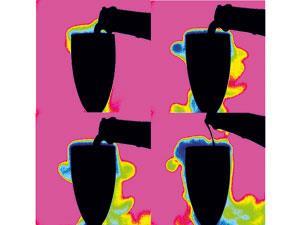
Through his visual investigations, Liger-Belair has revealed how these bubbles behave, helping champagne producers and drinkers alike. For example, you might have been told that the best champagnes are those with small bubbles. While the scientist in Liger-Belair notes that this isn’t necessarily true, customer pressure makes smaller bubbles more desirable to champagne producers, and therefore he has sought to help guarantee them.
‘We have spent a lot of time developing mathematical models that reproduce the growth of bubbles,’ Liger-Belair says. ‘One of the main parameters that explains the growth of bubbles is the concentration of dissolved CO2 in the champagne. The more dissolved CO2 you have, the bigger bubbles you will have. It is easy to reduce the CO2 dissolved in the wine by reducing the sugar that you add during the second fermentation. Many champagne manufacturers now do this to produce smaller bubbles.’
Bubbles even play a part in determining the aroma a drinker smells, Liger-Belair says. ‘When bubbles reach the champagne surface, most of them burst and project tiny droplets of champagne above the liquid surface,’ says Liger-Belair. ‘You have a huge quantity of droplets ejected above the champagne surface and a significant proportion of these evaporate. During the evaporation process, they transfer aroma into the vapour phase so that they can be smelt by the consumer.’
Flavour to savour
As well as looking striking and releasing aroma chemicals, bubbles have other effects that influence a drinker’s enjoyment. ‘We have pain receptors for CO2,’ explains Susan Ebeler from the University of California, Davis in the US. ‘If there are high levels of bubbles popping and activating the CO2 pain receptor in your mouth or nose, that’s going to interfere with the perception of taste and aroma.’
They also affect how precisely instrumental methods can capture the drinking experience. ‘When CO2 takes molecules into the air, it’s not a perfectly reproducible process. That makes it a little harder to make measurements,’ she explains.
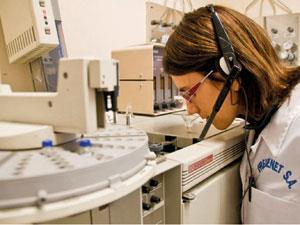
For such reasons, Ebeler exploited ‘sensory analysis’ by a team of extensively trained professional tasters to describe how a sparkling wine’s aroma changes as it ages.1 ‘After the second fermentation is over, yeast cells start to die and break open in an autolysis process,’ she explains. ‘Amino acids and sugars break down and further reactions occur as they get released into the solution along with yeast enzymes. There are some influences from grape variety on that and you can continue to tell the variety throughout that process.’
Susana Buxaderas from the University of Barcelona, Spain, has also used sensory methods to collect what colour, foaming and aroma properties experts prefer most. ‘The most valued properties include the quality of the bubbles, and whether a foam collar of bubble lace forms around the wine surface, following the glass circumference,’ she says. ‘The wine should have a pale yellow colour without any browning and a flavour with notes of toast, fruit and flowers.’
In collaboration with Barcelona-based sparkling wine producer Freixenet, Buxaderas has also used exclusively instrumental methods to find chemical markers that show how old Spanish cava sparkling wines are.2 To capture aroma compounds they used solid phase microextraction (SPME), which uses a narrow diameter fused silica fibre coated with material selected for its polarity. By then heating these fibres in a normal gas chromatography (GC) inlet, the scientists analysed volatile compounds in cavas of varying type and age. Aroma compounds such as diethyl succinate could be separated into groups according to how much is present in different wines. Buxaderas’ team was able to calculate a cava’s age from concentrations of key compounds with more than 73% accuracy.
A combined approach
But scientists must use multiple techniques to really understand what drinkers taste, Buxaderas says. ‘Fully assessing the sensory attributes of sparkling wine requires three different, complementary, approaches,’ she notes. ‘Gas chromatography-mass spectrometry (GC-MS) allows us to separate, detect and identify compounds emerging from the wine that can interact with human olfactory receptors,’ she explains. ‘But this type of chemical analysis cannot be directly related to sensory perception. Olfactometry, or sniffing, uses a panellist’s nose to detect the scent of each of the volatile compounds separated by GC. However, there are volatile compounds which cannot be associated with a characteristic scent because they do not have it by themselves.
Finally, descriptive sensory analysis requires a series of preliminary tastings so that all panellists together choose the words to describe the sensations detected. Panellists can then be trained to detect both an attribute and to quantify the aromatic sensation. After choosing appropriate descriptors and verifying panellists’ ability to detect these attributes, the results of descriptive sensory analysis are accepted as scientifically defining the aroma of wines.’ ?Jordi Torrens, from oenology R&D at Freixenet, feels that introducing instrumental approaches has paid sparkling wine producers dividends. ‘Identifying and quantifying individual volatiles through GC-MS on one hand, and sensory description through GC with olfactometric detection has been a big step forward in understanding the chemical aroma of wines,’ he comments. ‘Chromatography has allowed analysis of the minor components of wine, and has revolutionised the knowledge of itschemical composition.’
No pain is gain
Liger-Belair’s team is now closing the gap between the information obtained in real tasting conditions and by extracting aromas with SPME or GC before analysis on separate chromatographs. Rather than analysing the bulk liquid, they used glass slides to collect the aerosols emitted directly above champagne glasses.3 The aroma compounds were washed from the slides, and analysed using high resolution Fourier transform ion cyclotron resonance mass spectrometry (FT-ICR-MS). The resulting mass spectra were then compared with those for champagne in the glass. ‘These droplets are much more concentrated in many aromatic compounds than the champagne bulk,’ Liger-Belair explains. ‘This shows much of the aroma comes from surfactant-like molecules that prefer to gather at the interface rather than staying in the champagne bulk.’
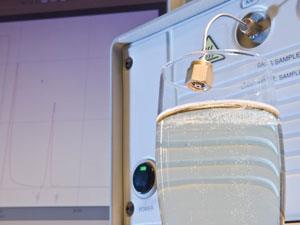
In early 2012, the scientists moved analysis closer still to real champagne drinking.4 They positioned a micro-GC inlet directly above the glass to measure ethanol and CO2 release. They then used this method – alongside infrared imaging to monitor CO2 release – to identify the perfect glass for enjoying champagne, assessing glasses ranging from very wide ‘coupe’ and very narrow ‘flute’ glasses.
‘We realised that the narrower aperture of the flute highly concentrates the CO2,’ Liger-Belair says. ‘This may be not a good thing for the consumer as it will irritate the nose during tasting and interfere with or completely mask aromas. The coupe dilutes CO2, which is good, but also dilutes aromas. The best shape is probably in between the coupe and the flute.’
Now Liger-Belair has demystified CO2 bubbles, the next most important questions for Marc Brevot, oenology project development manager at Moët & Chandon, concern oxygen. ‘Like any other wine, oxygen in champagne is involved in simple oxidations, like converting alcohol to acetic acid,’ he says. ‘It also undergoes a complex chain reaction catalysed by metal ions such as iron and copper which oxidises phenolic compounds into very reactive forms. Thanks to reactions like these, to really fine tune the targeted style it is necessary to define how much oxygen you can allow to interact at each step of the process.’
Going out with a bang
Moët & Chandon has therefore developed field tools to precisely measure and control oxygen levels during the different production stages. For example, after at least 24 months of the prise de mousse, champagne bottles are upturned and the necks frozen, trapping dead yeast cells in a small ice plug. Winemakers then uncap the bottles and, thanks to the pressure of CO2, the ice explodes out and removes the sediment. While the bottles are quickly resealed to retain the maximum gas possible, Moët & Chandon also injects some additional wine as a jet that foams and pushes oxygen out.
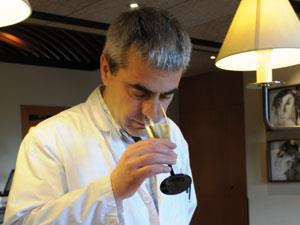
Brevot also wants to understand oxygen’s chemistry in champagne better. ‘We definitely need to understand oxygen’s influence in a more detailed way, in order to adapt our winemaking in the future,’ he says. ‘What precise influences on wine taste and ageing can oxygen uptake have from pressing to cellar maturation? Discovering these intimate laws ruling the maturation of our wines and the ageing process after disgorgement is especially interesting.’
But fully understanding how chemicals provide sparkling wine’s flavour is still out of reach, Freixenet’s Torrens warns. ‘Perhaps one of the most important challenges is to understand the synergies and antagonisms that occur between aroma and taste compounds and interpret the sensory perceptions chemically,’ he says. ‘That needs new technologies such as electronic noses and tongues, which are still far from describing the sensations produced by wine tasting by themselves.’
Nevertheless, understanding how the thousands of different aroma molecules work together is one of the next problems Liger-Belair and his fellow researchers hope to answer. ‘Combining chemistry with sensory analysis for this is very complex,’ he says. ‘The future of champagne science lies in determining which techniques are important for such experiments.’
As researchers continue to refine these methods, drinkers and producers alike can hope that they will amplify sparkling wines’ power to mark a celebration out as special. And perhaps the result will be drinks that illuminate the senses even more brightly, and imprint the happiest memories in our minds even more indelibly.
References
- C de la Presa-Owens et al, Am. J. Enol. Vitic. 1998, 49, 289
- S Francioli et al, Am. J. Enol. Vitic. 2003, 54, 158
- G Liger-Belair et al, Proc. Natl. Acad. Sci. USA, 2009, 106, 16545 (DOI: 10.1073/pnas.0906483106)
- G Liger-Belair et al, PLoS One, 2012, 7, e30628 (DOI: 10.1371/journal.pone.0030628)

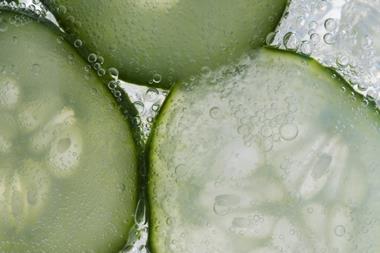









1 Reader's comment